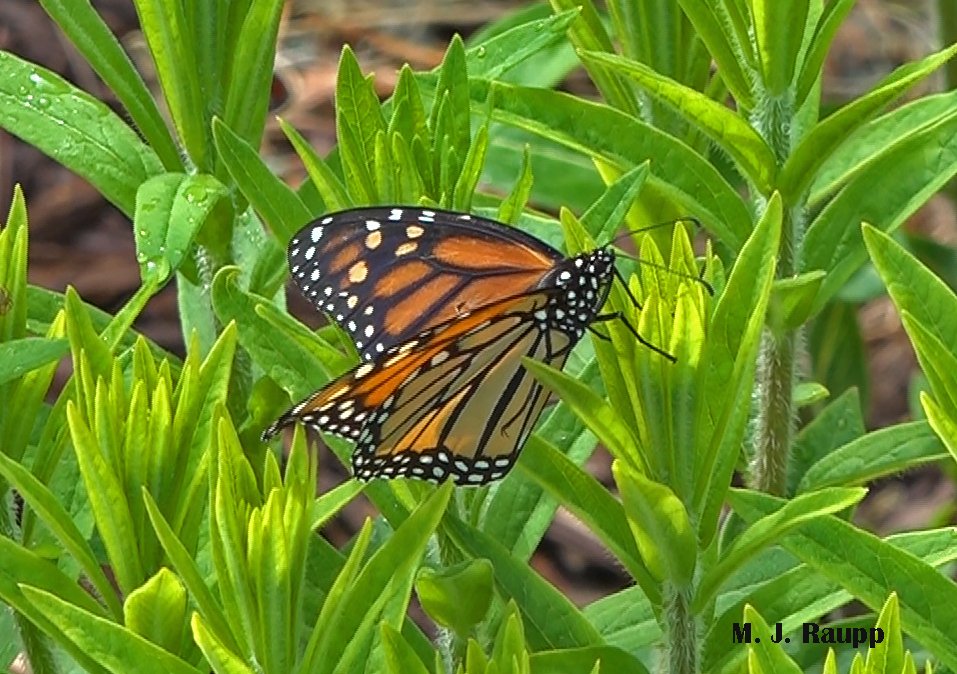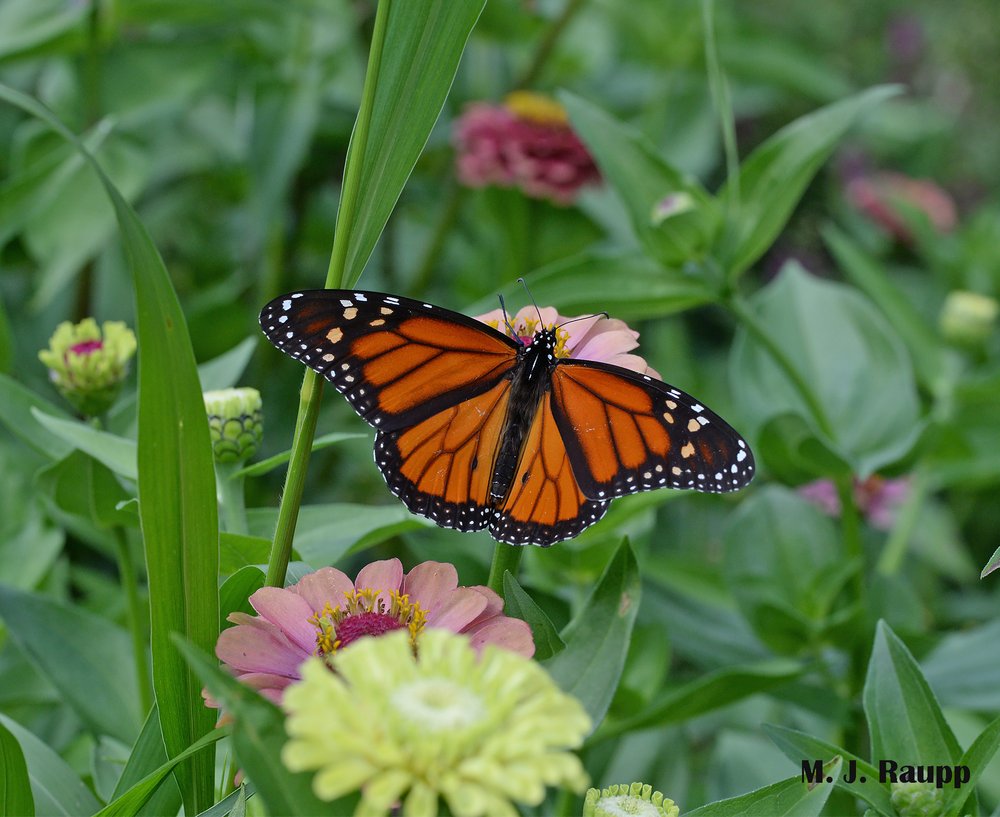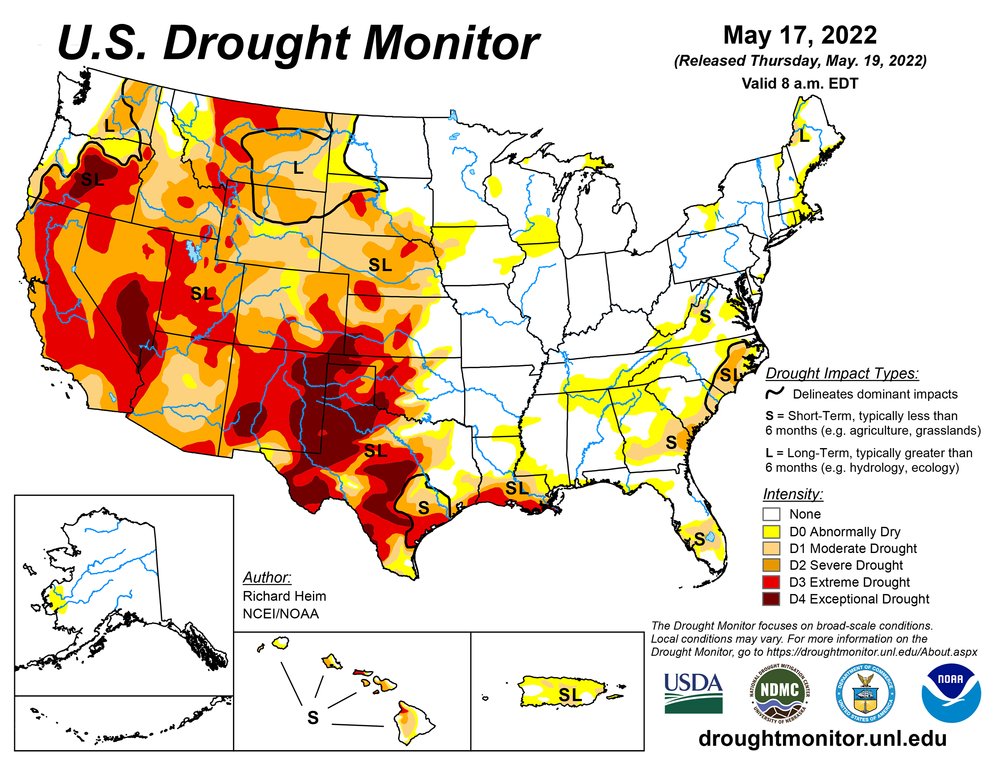A surprisingly early visit by a royal: Monarch butterflies and their caterpillars, Danaus plexippus

This pretty monarch arrived early to the milkweed patch this year.

Zinnias are dynamite attractors for many butterflies, including male monarchs.
In a previous episode of Bug of the Week back way back in 2011, we visited monarch butterflies that debuted in my flower garden in mid-June. Fast forward to 2022 when a Bug of the Week enthusiast announced the arrival of a monarch in her yard the second week of April. Thinking this early appearance was somewhat anomalous, I congratulated her on her good fortune and wondered what meteorological mystery might have promoted such early arrival of this voyager from down south. Problem was milkweeds here in the DMV were not even close to providing food for monarch caterpillars in early April. No telling what happened to that premature wanderer.
Well, almost two weeks ago in early May, a beautiful female monarch discovered my small patch of butterfly weed and bestowed more than a dozen eggs to several sprouts over a few days. At last count, fourteen small caterpillars were enjoying milkweed leaves to get nutrients and hopefully a sufficient dose of cardiac glycosides to thwart predators. In previous episodes we delved into clever defenses of monarch caterpillars and butterflies acquired from noxious chemicals found in leaves of milkweeds on which they dine. My observation of a female monarch and her caterpillars is not the first report of this iconic butterfly moving up the East Coast this spring. Journey North, a really cool migrant-tracking website, recently reported monarch adults in New Jersey and caterpillars in other locations in Maryland and Pennsylvania. What surprises me is how early monarch caterpillars arrived in my garden. Historically, eggs and larvae don’t usually appear at my home until June or July. Perhaps this is just another indication of how our ever-warming world affects the plants and animals.
Friday May 13th was a lucky day when this pretty monarch female stopped by my small patch of butterfly weed. Watch as she curls her abdomen and deposits an egg. Within days the egg hatched and a very tiny caterpillar just a few millimeters long began to dine on milkweed leaves. As the caterpillar grows, it eats more each day. One week after hatching the half-grown caterpillars make leaves disappear very fast. At last count, more than a dozen caterpillars of various sizes are dining on milkweeds in the milkweed patch.
While western populations of migratory monarchs enjoyed an unexpected, remarkable rebound last winter, in January Monarch Watch provided a rather gloomy projection of the population size of eastern migratory monarchs overwintering in Mexico. Continued exceptional drought west of the Mississippi and extreme heat in other parts of our land could spell trouble for milkweeds that monarchs depend on for food. Trouble, too, for adult butterflies and their young, which are imperiled by high temperatures. In the short run, we can do our part for monarchs by providing appropriate food for adults and their young by planting regionally native milkweeds for caterpillars and nutritious nectar sources for adults. Studies by Adam Baker and Daniel Potter discovered that garden design can play an important role in monarch conservation. Milkweeds with adult nectar sources nearby, planted along perimeters of gardens or relatively isolated from other non-host plants, were those most likely to have monarch eggs and caterpillars compared to milkweeds mixed with or hidden by other vegetation. In the long run, not only for monarchs but for all living things, we better find ways to cool this planet down.

Will exceptional drought and extreme heat imperil milkweeds and monarchs as they continue their annual migrations? Graph credit: Richard Heim, NCEI/NOAA
Acknowledgements
Bug of the Week thanks Aimee for sharing her monarch sighting that served as the inspiration for this episode. Paula Shrewsbury provided video content. The fascinating article “Configuration and Location of Small Urban Gardens Affect Colonization by Monarch Butterflies” by Adam Baker and Daniel Potter provided several cool insights into monarch behavior. The following article from the University of Maryland IPM newsletter provides more detail on monarch conservation methods in the “Beneficial of the Week” article on page 8: https://extension.umd.edu/sites/extension.umd.edu/files/2021-09/21Sep03L.pdf
This post appeared first on Bug of the Week